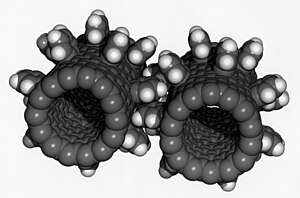
Back Nanotegnologie Afrikaans Nanotechnologie ALS Nanotecnolochía AN تقانة النانو Arabic Nanoteunoloxía AST Nanotexnologiya Azerbaijani نانوتکنولوژی AZB Нанотехнология Bashkir Nanotechnologie BAR Nanuoteknuoluogėjė BAT-SMG

| Part of a series of articles on |
| Nanotechnology |
|---|
| Impact and applications |
| Nanomaterials |
| Molecular self-assembly |
| Nanoelectronics |
| Nanometrology |
| Molecular nanotechnology |
Nanotechnology is the manipulation of matter with at least one dimension sized from 1 to 100 nanometers (nm). At this scale, commonly known as the nanoscale, surface area and quantum mechanical effects become important in describing properties of matter. This definition of nanotechnology includes all types of research and technologies that deal with these special properties. It is common to see the plural form "nanotechnologies" as well as "nanoscale technologies" to refer to research and applications whose common trait is scale.[1] An earlier understanding of nanotechnology referred to the particular technological goal of precisely manipulating atoms and molecules for fabricating macroscale products, now referred to as molecular nanotechnology.[2]
Nanotechnology defined by scale includes fields of science such as surface science, organic chemistry, molecular biology, semiconductor physics, energy storage,[3][4] engineering,[5] microfabrication,[6] and molecular engineering.[7] The associated research and applications range from extensions of conventional device physics to molecular self-assembly,[8] from developing new materials with dimensions on the nanoscale to direct control of matter on the atomic scale.
Nanotechnology may be able to create new materials and devices with diverse applications, such as in nanomedicine, nanoelectronics, biomaterials energy production, and consumer products. However, nanotechnology raises issues, including concerns about the toxicity and environmental impact of nanomaterials,[9] and their potential effects on global economics, as well as various doomsday scenarios. These concerns have led to a debate among advocacy groups and governments on whether special regulation of nanotechnology is warranted.
- ^ Drexler KE (1986). Engines of Creation: The Coming Era of Nanotechnology. Doubleday. ISBN 978-0-385-19973-5. OCLC 12752328.
- ^ Drexler KE (1992). Nanosystems: Molecular Machinery, Manufacturing, and Computation. Wiley. ISBN 978-0-471-57547-4. OCLC 26503231.
- ^ Hubler A (2010). "Digital quantum batteries: Energy and information storage in nanovacuum tube arrays". Complexity. 15 (5): 48–55. doi:10.1002/cplx.20306. ISSN 1076-2787. S2CID 6994736.
- ^ Shinn E (2012). "Nuclear energy conversion with stacks of graphene nanocapacitors". Complexity. 18 (3): 24–27. Bibcode:2013Cmplx..18c..24S. doi:10.1002/cplx.21427. S2CID 35742708.
- ^ Elishakoff I, Dujat K, Muscolino G, Bucas S, Natsuki T, Wang CM, et al. (March 2013). Carbon Nanotubes and Nano Sensors: Vibrations, Buckling, and Ballistic Impact. John Wiley & Sons. ISBN 978-1-84821-345-6.
- ^ Lyon D, Hubler A (2013). "Gap size dependence of the dielectric strength in nano vacuum gaps". IEEE Transactions on Dielectrics and Electrical Insulation. 20 (4): 1467–71. doi:10.1109/TDEI.2013.6571470. S2CID 709782.
- ^ Saini R, Saini S, Sharma S (January 2010). "Nanotechnology: the future medicine". Journal of Cutaneous and Aesthetic Surgery. 3 (1): 32–33. doi:10.4103/0974-2077.63301. PMC 2890134. PMID 20606992.
- ^ Belkin A, Hubler A, Bezryadin A (February 2015). "Self-assembled wiggling nano-structures and the principle of maximum entropy production". Scientific Reports. 5: 8323. Bibcode:2015NatSR...5.8323B. doi:10.1038/srep08323. PMC 4321171. PMID 25662746.
- ^ Buzea C, Pacheco II, Robbie K (December 2007). "Nanomaterials and nanoparticles: sources and toxicity". Biointerphases. 2 (4): MR17 – MR71. arXiv:0801.3280. doi:10.1116/1.2815690. PMID 20419892. S2CID 35457219.